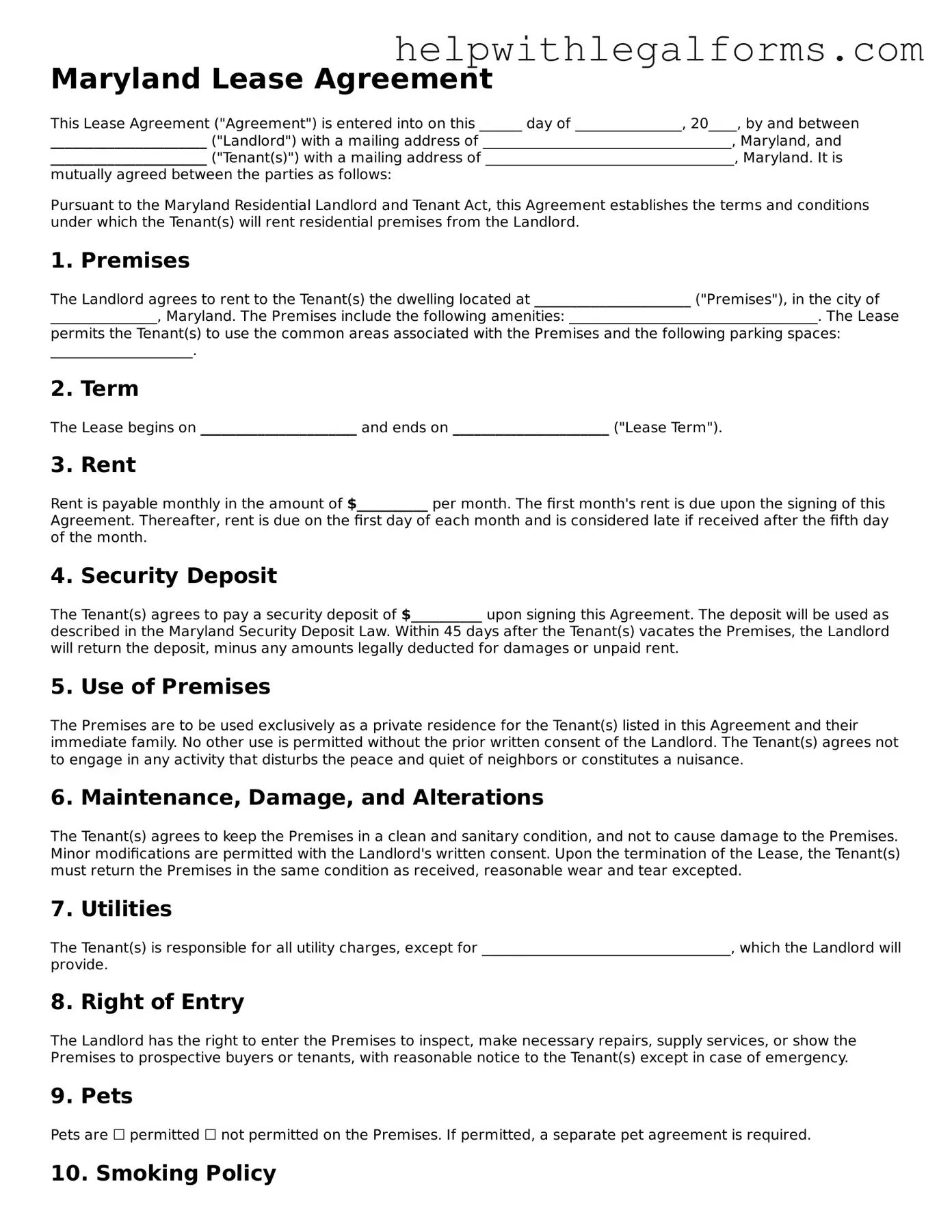Maryland Lease Agreement
This Lease Agreement ("Agreement") is entered into on this ______ day of _______________, 20____, by and between ______________________ ("Landlord") with a mailing address of ___________________________________, Maryland, and ______________________ ("Tenant(s)") with a mailing address of ___________________________________, Maryland. It is mutually agreed between the parties as follows:
Pursuant to the Maryland Residential Landlord and Tenant Act, this Agreement establishes the terms and conditions under which the Tenant(s) will rent residential premises from the Landlord.
1. Premises
The Landlord agrees to rent to the Tenant(s) the dwelling located at ______________________ ("Premises"), in the city of _______________, Maryland. The Premises include the following amenities: ___________________________________. The Lease permits the Tenant(s) to use the common areas associated with the Premises and the following parking spaces: ____________________.
2. Term
The Lease begins on ______________________ and ends on ______________________ ("Lease Term").
3. Rent
Rent is payable monthly in the amount of $__________ per month. The first month's rent is due upon the signing of this Agreement. Thereafter, rent is due on the first day of each month and is considered late if received after the fifth day of the month.
4. Security Deposit
The Tenant(s) agrees to pay a security deposit of $__________ upon signing this Agreement. The deposit will be used as described in the Maryland Security Deposit Law. Within 45 days after the Tenant(s) vacates the Premises, the Landlord will return the deposit, minus any amounts legally deducted for damages or unpaid rent.
5. Use of Premises
The Premises are to be used exclusively as a private residence for the Tenant(s) listed in this Agreement and their immediate family. No other use is permitted without the prior written consent of the Landlord. The Tenant(s) agrees not to engage in any activity that disturbs the peace and quiet of neighbors or constitutes a nuisance.
6. Maintenance, Damage, and Alterations
The Tenant(s) agrees to keep the Premises in a clean and sanitary condition, and not to cause damage to the Premises. Minor modifications are permitted with the Landlord's written consent. Upon the termination of the Lease, the Tenant(s) must return the Premises in the same condition as received, reasonable wear and tear excepted.
7. Utilities
The Tenant(s) is responsible for all utility charges, except for ___________________________________, which the Landlord will provide.
8. Right of Entry
The Landlord has the right to enter the Premises to inspect, make necessary repairs, supply services, or show the Premises to prospective buyers or tenants, with reasonable notice to the Tenant(s) except in case of emergency.
9. Pets
Pets are ☐ permitted ☐ not permitted on the Premises. If permitted, a separate pet agreement is required.
10. Smoking Policy
Smoking is ☐ allowed ☐ not allowed on the Premises.
11. Governing Law
This Agreement shall be governed by and construed in accordance with the laws of the State of Maryland.
12. Additional Terms and Conditions
_________________________________________________________________________________________________________________________
13. Agreement to Terms
By signing below, the Landlord and Tenant(s) acknowledge and agree to all terms and conditions outlined in this Maryland Lease Agreement.
Landlord Signature: ______________________________ Date: _______________
Tenant Signature(s): ______________________________ Date: _______________
